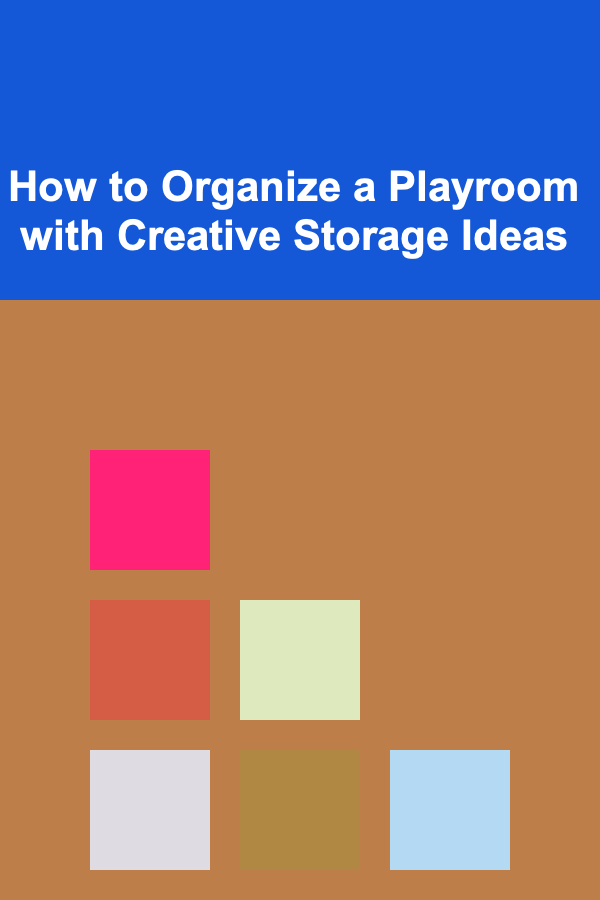
Why A Tidy Workspace Boosts Creativity and Innovation
ebook include PDF & Audio bundle (Micro Guide)
$12.99$5.99
Limited Time Offer! Order within the next:

In today's fast-paced world, the importance of a tidy workspace cannot be overstated. As more people work from home or in flexible office environments, the way we organize our space directly impacts our productivity, creativity, and overall well-being. This article will explore the relationship between a tidy workspace and enhanced creativity and innovation, examining psychological principles, practical strategies, and real-world examples.
Introduction
Creativity and innovation are essential components of success in any field, whether in business, art, science, or personal projects. However, fostering an environment that encourages creative thought requires careful consideration of various factors, including the physical workspace. Numerous studies have shown that a tidy workspace can lead to increased creativity and innovation, providing a clear path for individuals to unlock their potential.
This article delves into understanding how a tidy workspace boosts creativity and innovation, backed by psychological theories, practical advice, and illustrative case studies.
The Psychology of Clutter
2.1 Cognitive Overload
Cognitive overload occurs when the brain is bombarded with too much information, leading to decreased performance and creativity. A cluttered workspace can contribute to this overload by presenting numerous competing stimuli. When faced with distractions, the mind struggles to focus on creative tasks.
Example:
Imagine sitting at a desk filled with stacks of papers, unorganized files, and miscellaneous items. Each element draws your attention, making it difficult to concentrate on your current project. In contrast, a tidy workspace allows the mind to focus on one task at a time, promoting deeper thinking and innovative ideas.
2.2 The Role of Visual Noise
Visual noise refers to the cluttered scenery that surrounds us, which can significantly affect our cognitive processes. Research indicates that excessive visual stimuli can hinder creativity:
- Distraction: Clutter creates constant distractions that can lower attention spans.
- Impeded Thought Processes: A chaotic environment can disrupt the flow of ideas, making it challenging to develop new concepts.
A tidy workspace minimizes visual noise, enabling clearer thinking and greater creativity.
2.3 Emotional Responses to Clutter
Clutter can trigger negative emotions, such as stress and anxiety. These feelings can stifle creativity, making it harder to generate ideas. Conversely, a clean and organized space fosters positive emotions:
- Calmness: A tidy workspace promotes tranquility, encouraging individuals to engage in creative endeavors.
- Confidence: A well-organized area enhances self-efficacy, allowing individuals to feel more competent when tackling challenges.
Creating an emotionally supportive environment is crucial for stimulating creativity.
Benefits of a Tidy Workspace
3.1 Increased Focus
A tidy workspace naturally invites focus. With fewer distractions vying for attention, individuals are better positioned to immerse themselves fully in tasks. This concentrated effort encourages deeper exploration of ideas, leading to innovative solutions.
3.2 Enhanced Problem Solving
Creativity often stems from the ability to solve problems in unique ways. A tidy workspace facilitates this process by:
- Providing Clarity: Clear surfaces allow for more straightforward brainstorming without the hindrance of clutter.
- Allowing Flexibility: An organized environment enables quick adjustments and changes in the workflow.
When individuals can think more clearly, they are more likely to make connections between disparate ideas, leading to inventive solutions.
3.3 Improved Mood and Motivation
A tidy workspace can positively influence mood and motivation levels. When individuals take pride in their surroundings, they are more inclined to engage actively in their work. An organized space contributes to a sense of control and accomplishment, which can fuel further creativity.
3.4 Better Time Management
Time management is crucial for enhancing creativity. A tidy workspace reduces the time spent searching for materials or tools, allowing individuals to devote more energy to creative tasks. By streamlining workflows, employees can maximize productive hours dedicated to innovation.
Strategies for Maintaining a Tidy Workspace
4.1 Decluttering Techniques
Decluttering is the first step toward establishing a tidy workspace. Here are some effective techniques:
- The One-Year Rule: If you haven't used it in the last year, consider removing it from your space.
- Categorize and Prioritize: Group similar items together and prioritize what needs to stay based on its usefulness.
- Daily Declutter: Set aside a few minutes each day to tidy up and remove unnecessary items.
4.2 Organizing Tools and Systems
Implementing specific systems can significantly enhance organization:
- Storage Solutions: Use baskets, bins, or drawer organizers to store supplies efficiently.
- Labeling: Clearly label storage areas and folders to facilitate easy access.
- Digital Organization: For digital workspaces, utilize file management software to keep everything in order.
4.3 Daily Habits for Tidiness
Developing daily habits helps maintain a tidy workspace:
- End-of-Day Routine: Dedicate the last five to ten minutes of each workday to tidy up your area.
- Maintain Minimalism: Regularly assess your belongings and eliminate anything unnecessary.
- Set Boundaries: Limit the number of items allowed on your desk to minimize clutter.
Creating an Inspiring Workspace
5.1 Personalization
Personalizing your workspace can boost creativity and enjoyment:
- Artwork and Decor: Add pieces that inspire you, whether it's artwork, photographs, or motivational quotes.
- Comfort Items: Introduce items such as cushions or plants that enhance comfort and create a welcoming atmosphere.
5.2 Incorporating Nature
Nature has been shown to improve mood and creativity. Consider adding elements like indoor plants or natural light sources to your workspace. Research suggests that exposure to nature increases cognitive function and creativity.
5.3 Design and Layout Considerations
The layout of your workspace matters. Ensure that your setup is conducive to focus and creativity:
- Ergonomic Furniture: Invest in comfortable chairs and desks that support posture and reduce fatigue.
- Zoning: Create distinct zones for different activities to promote mental separation between tasks.
Real-World Examples and Case Studies
To illustrate the impact of a tidy workspace on creativity and innovation, let's look at some real-world examples.
Google's Office Design
Google is famous for its innovative work culture and creative spaces. Their offices incorporate open layouts, inspiring decor, and designated relaxation areas, fostering collaboration and creativity. Employees are encouraged to personalize their spaces, leading to higher engagement and innovation.
Pixar Animation Studios
Pixar emphasizes the importance of a tidy workspace through their studios. They utilize open floor plans to encourage communication while ensuring individual workstations remain organized. This balance promotes both collaboration and focused creativity, resulting in groundbreaking animated films.
Microsoft's Research on Workspaces
Microsoft has conducted numerous studies highlighting the connection between workspace organization and productivity. Their findings suggest that employees who maintain tidy workspaces experience improved focus and creativity, ultimately contributing to enhanced innovation.
Conclusion
A tidy workspace plays a pivotal role in fostering creativity and innovation. By reducing cognitive overload, minimizing visual noise, and supporting emotional well-being, an organized environment allows individuals to tap into their creative potential more effectively.
Through practical strategies for decluttering, organizing, and personalizing workspaces, anyone can create an environment that inspires innovative thinking. Whether you're an entrepreneur, student, or professional, investing time in managing your workspace will yield significant dividends in terms of creativity, productivity, and overall job satisfaction.
Start today by assessing your own workspace and implementing small changes that can lead to a more organized and inspiring environment. Remember---the tidier your workspace, the more likely you are to innovate and create!

How to Decorate Your Fireplace Mantel for the Holidays
Read More
How to Host a Dinner Party with a Simple Yet Elegant Menu
Read More
How to Organize a Playroom with Creative Storage Ideas
Read More
How to Plan an Eco-Friendly Party That's Both Fun and Green
Read More
How to Use Meal Prep to Save Time and Money
Read More
What Are the Best Storage Solutions for Small Apartments?
Read MoreOther Products

How to Decorate Your Fireplace Mantel for the Holidays
Read More
How to Host a Dinner Party with a Simple Yet Elegant Menu
Read More
How to Organize a Playroom with Creative Storage Ideas
Read More
How to Plan an Eco-Friendly Party That's Both Fun and Green
Read More
How to Use Meal Prep to Save Time and Money
Read More